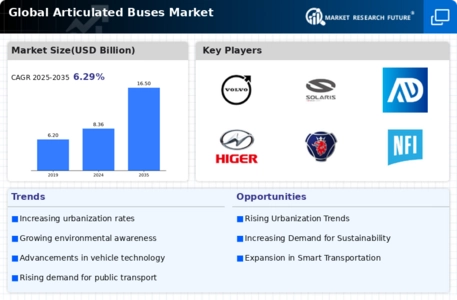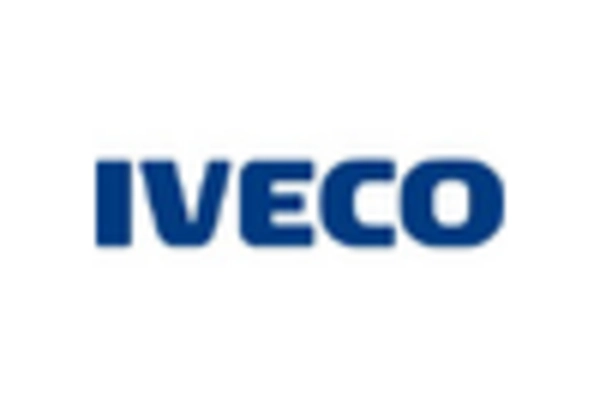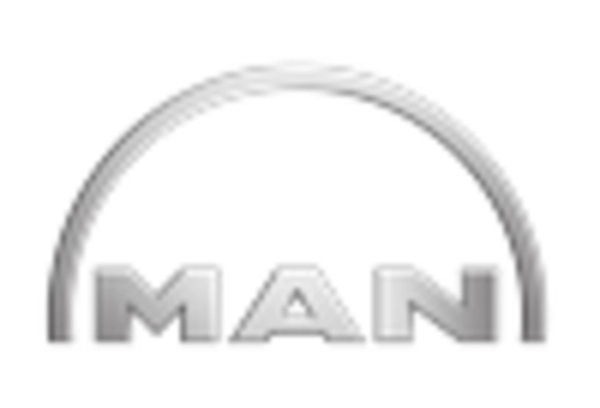Rising Fuel Prices
Rising fuel prices are influencing the articulated buses market by prompting transit authorities to seek more fuel-efficient alternatives. As fuel costs continue to fluctuate, the operational expenses associated with traditional diesel buses become a concern for many public transport operators. Articulated buses, particularly those utilizing alternative fuels or hybrid technologies, offer a potential solution to mitigate these costs. In 2024, it is projected that the market for alternative fuel vehicles will grow by 15% annually, with articulated buses being a key segment. This shift towards more economical and environmentally friendly options is likely to drive demand for articulated buses, as transit agencies aim to reduce their overall fuel consumption and enhance the sustainability of their operations.
Urbanization Trends
The ongoing trend of urbanization is a significant driver for the articulated buses market. As more people migrate to urban centers, the demand for efficient public transportation solutions intensifies. Articulated buses, with their ability to carry a larger number of passengers compared to standard buses, are well-suited to meet this growing demand. In 2023, urban areas accounted for over 55% of the global population, and this figure is expected to rise. Consequently, cities are increasingly investing in articulated bus systems to alleviate congestion and provide reliable transit options. The expansion of urban areas necessitates the development of robust public transport networks, and articulated buses are likely to play a central role in this evolution, thereby driving market growth.
Technological Innovations
Technological advancements are reshaping the articulated buses market, enhancing operational efficiency and passenger experience. Innovations such as advanced telematics, automated driving systems, and real-time tracking applications are becoming increasingly prevalent. These technologies not only improve safety but also optimize route management and fuel efficiency. For instance, the integration of smart technologies allows for better monitoring of vehicle performance, which can lead to reduced maintenance costs and improved service reliability. In 2024, it is projected that the market for smart transportation solutions will reach 50 billion USD, with articulated buses playing a crucial role in this growth. As cities adopt these technologies, the demand for articulated buses equipped with cutting-edge features is likely to surge, further driving market expansion.
Sustainability Initiatives
The increasing emphasis on sustainability is a pivotal driver for the articulated buses market. As urban areas grapple with pollution and traffic congestion, articulated buses present a viable solution by offering higher passenger capacity and reduced emissions per capita. Many cities are transitioning to greener public transport options, with articulated buses often being equipped with hybrid or electric powertrains. This shift aligns with global sustainability goals, as articulated buses can significantly lower the carbon footprint of public transportation systems. In 2023, the market for electric buses, including articulated models, was valued at approximately 20 billion USD, indicating a robust growth trajectory. The focus on sustainability not only enhances the appeal of articulated buses but also encourages investments in infrastructure that supports their operation, thereby propelling the market forward.
Government Support and Funding
Government investments and support are critical drivers for the articulated buses market. Many governments are recognizing the need for efficient public transportation systems and are allocating funds to enhance urban mobility. This includes investments in articulated bus fleets, which are often seen as a cost-effective solution to address overcrowding in public transport. In 2025, it is anticipated that public sector funding for transportation infrastructure will exceed 100 billion USD globally, with a significant portion directed towards the procurement of articulated buses. Such financial backing not only facilitates the acquisition of new vehicles but also supports the development of necessary infrastructure, such as dedicated bus lanes and charging stations for electric models. This government involvement is likely to stimulate market growth and encourage the adoption of articulated buses in various regions.


















Leave a Comment